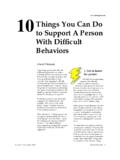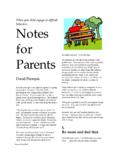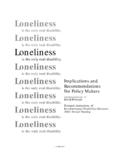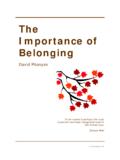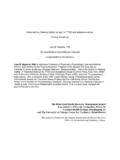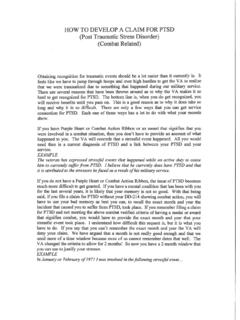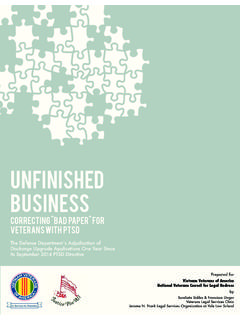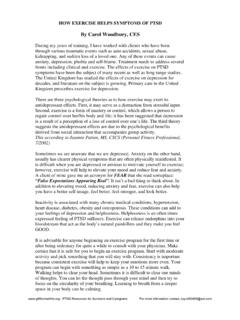Transcription of Supporting a Person Who Is Experiencing Post …
1 Supporting a Person Who Is ExperiencingPost traumatic stress Disorder ( ptsd )1 David Pitonyak, darkness my old and GarfunkleIt s like a snapshot that comes back in my mind in perfect detail, without any words to explain s people are frequently misdiagnosed and mistreated in the mental health system. Because of the numberand complexity of their symptoms, their treatment is often fragmented and incomplete. Because of their characteristicdifficulties with close relationships, they are vulnerable to become re-victimized by caregivers. They may become engagedin ongoing, destructive interactions, in which the replicates the behavior of the abusive is about separation from the people or beliefs that protect, nurture and guide is all about creating attachment in a Person s life.
2 It s about the relief of Elia Vecchione1 There are a number of people who have helped me to understand the impact of post traumatic stress Disorderon the lives of people with disabilities. I am especially thankful to Dr. Elia Vecchione, , of Upper Valley Services inVermont, for helping me to understand that despite the terrible things that have happened to some very good people, healing ispossible. Al and his colleagues save lives every day. And, in the scheme of things, it doesn t get any better than that. If you chooseto duplicate this material, please be mindful that much of it is adapted or taken directly from these sources: (1) Legare, G,Ryan, R. & Lewis Herman, J (1998) Exploring the possible impact of trauma.
3 Camp Hill, PA: Contract Consultants, Inc. (2) Gabriel, S.(1996). The psychiatric tower of babble: Understanding people with developmental disabilities who have mental illness. Eastman, Quebec: Diverse CityPress. (3) Ryan, R. (1996). Handbook of mental health care for persons with developmental disabilities. Denver, CO: The Community CirclePublications. (4) Vecchione, A. (1996). The trauma and recovery handbook: A guide to developing programs for individuals with mental , VT: Upper Valley Services (5) Vecchione, A. (1996). Supporting people who have been traumatized. Presentation at the April,1996 Vermont Providers Conference. Rutland, (6) Flannery, (1998). post - traumatic stress Disorder: The victim s guide tohealing and recovery.
4 New York, NY: Crossroad Publishing Company. (7) James, B. (1994). Handbook for treatment of attachment-traumaproblems in children. New York: Simon and Shuster. (Version: 1 June 2016).1 David Pitonyak, Understanding stress Disorder ( ptsd ) is said to occur in 1% of the general population andin of persons exposed to trauma. who experience disabilities are more likely than non-disabled people to be abusedphysically, emotionally, or sexually (Keesler, 2014). Ryan (1994) estimates that 61% of thepeople with developmental disabilities living in a hospital setting met the criteria for ptsd (see also Pease, 2003; Sorensen, 2003). and de Jongh (2010) point out that, to date, Although there is evidence to suggestthat people with intellectual disabilities are likely to suffer from post traumatic StressDisorder ( ptsd ), reviews of the evidence base, and the potential consequences of thiscontention are possible.
5 They call for the development of diagnostic instruments ofPTSD symptomatology to facilitate future research (pps 308-316).4. traumatic events may include one or more of the following2 from primary relationships at an early moves from residential of parent, sibling, or significant medical the name of treatment, professionals may expose the individual to trauma. The followingprocedures are common in the lives of people who experience disabilities: screening2 Vecchione, A. (1996). The trauma and recovery handbook: A guide to developing programs for individuals with mental , VT: Upper Valley Pitonyak, or other aversive reasons for referral3 (inexplicable) bout or episodes of episodes of screaming, throwing things or destruction of of proportion kinds of reactions to normal changes or stressors.
6 People whohave an out of proportion reaction to moderately stressful but not catastrophicsituation may have had something worse happen to them in the past that is stirred upby the physical assault (often on the people they like). extremely afraid (terrified) of people they know and trust at someone they know by a different unfocused, not with it (speculated seizures). behaving like they are somewhere to respond to people during the found in Person s histories4 Person has received all kinds of psychotropic Person has a vague and unclear psychiatric diagnosis; more often a collection ofdifferent diagnoses over the problem behaviors were unintentionally attributed to his/her history of placements, referrals, comprehensive behavioral interventions andmany consultations have been arranged over time.
7 If positive results were found,they were short term and would not be generalized to the rest of the Person s Person a severe reputation as being manipulative, aggressive, explosive Person has spent a lot of time in restrictive settings (seclusion and restraints). have a very expensive support is not uncommon for a Person Experiencing ptsd to also be Experiencing , or to havebeen labeled with, one or more of the following: depression, Schizophrenia, autism, alcoholabuse, dissociative disorder, kleptomania, pedophilia, panic disorder, anxiety disorder,Tourette Syndrome, Asperger s L gar , G., Ryan, R., & Lewis Herman, J. (1998) Exploring the possible impact of trauma. Camp Hill, PA: ContractConsultants, Ibid., p. 23 David Pitonyak, Diagnostic criteria for PTSD5: event.
8 The Person has been exposed to a traumatic event in which oneor both of the following were Person experienced, witnessed, or was confronted with an event orevents that involved actual or threatened death or serious injury, or a threatto the physical integrity of self or Person s response involved intense fear, helplessness, or re- Experiencing . The traumatic event is persistently re-experienced inone (or more) of the following and intrusive distressing recollections of the event, includingimages, thoughts, or perceptions (body memories or conversion disorders (not a conscious recollection of what they are re- Experiencing but willexperience the same physical pain). distressing dreams of the event (nightmares). or feeling as if the traumatic event were recurring (includes a sense ofreliving the experience, illusions, hallucinations and dissociative flashbackepisodes, including those that occur on awakening or when intoxicated).)
9 Psychological distress at exposure to internal or external cues(triggers) that symbolize or resemble an aspect of the traumatic reactivity on exposure to internal or external cues thatsymbolize or resemble an aspect of the traumatic : Persistent avoidance of stimuli associated with the trauma and numbingof general responsiveness (not present before trauma), as indicated by three of to avoid thoughts, feelings, or conversation associated with to avoid activities, places, or people that arouse recollections of thetrauma (these may appear as unusual phobias or, for example, avoiding theDoctor s office, a former place where the Person lived, certain types ofclothes people won t touch, certain rooms, sounds, smells, etc.)
10 To recall an important aspect of the diminished interest or participation in significant of detachment or estrangement from range of affect (unable to have loving feelings).5 L gar , G., Ryan, R., & Lewis Herman, J. (1998)., pp. Pitonyak, of a foreshortened future (the Person does not expect to have a career,significant relationships or a normal life span). vigilance/increased arousal: Persistent symptoms of increased arousal (notpresent before the trauma), as indicated by two (or more) of the falling or staying or outburst of or exaggerated startle : To meet the criteria, the cluster of symptoms has to be present for at leastone impairment: The disturbance causes clinically significant distress orimpairment in social, occupational, or other important areas of Features (DSM-IV).

